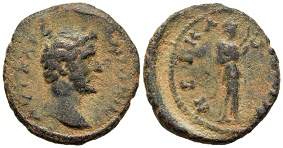Fine Coins Showcase
Antiquities Showcase
Show Empty Categories
Shop Search
Shopping Cart
My FORVM
Contact Us
About Forum
Shopping at Forum
Our Guarantee
Payment Options
Shipping Options & Fees
Privacy & Security
Forum Staff
Selling Your Coins
Identifying Your Coin
FAQs
zoom.asp
Home ▸ Catalog ▸ |Themes & Provenance| ▸ |Gods, Non-Olympian| ▸ |Hygieia or Salus||View Options:   | | | | | | Hygieia is usually said to be a daughter of Asklepios, along with her sisters, Panacea and Iaso. Hygieia, though, was the most important of the attendants of Asklepios and was thought by some in antiquity to be not his daughter but his wife. She was more important than other members of the family and more on par with Asklepios himself. Hygieia is remembered today in the word, "hygiene." She appears on numerous coins, usually depicted feeding the sacred snake from a patera. Salus was the Roman goddess of health, identified by the Romans with the Greek Hygiea. |


Nicaea remained an important town throughout the imperial period. Although only 70 km (43 miles) from Constantinople, Nicaea did not lose its importance when Constantinople became the capital of the Eastern Empire. The city suffered from earthquakes in 358, 362 and 368; after the last of which, it was restored by Valens. During the Middle Ages, it was a long time bulwark of the Byzantine emperors against the Turks.RP113281. Bronze AE 17, apparently unpublished variant; RIC IV.1 T5889 var. (obv. leg.); SNG Cop 474 (same); Rec Gén 95.2, pl. LXIX.2 (rev. only) (same), VF, rev. off centered, porosity, light marks, clay-rich sediments, weight 3.752 g, maximum diameter 19.5 mm, Nicaea (Iznik, Turkey) mint, 138 - 161 A.D.; obverse AVT KAIC ANTΩNINO-C, Bare head right; reverse NEIKA-IEΩN, Hygieia standing right, feeding serpent in her arms from patera in right hand; extremely rare; $110.00 (€103.40)
Valerian I, October 253 - c. June 260 A.D., Cotiaeum, Phrygia


Asklepios is the Greek god of medicine. Hygieia is the goddess of health and Asklepios' daughter. Telesphoros is Asklepios' assistant. Asklepios learned the secrets of keeping death at bay after observing one snake bringing another snake healing herbs. Woman seeking fertility, the sick, and the injured slept in his temples in chambers where non-poisonous snakes were left to crawl on the floor and provide healing.RP110209. Bronze tetrassarion, SNG Hunt 2048; SNG Mu 333 var. (rev. leg.); SNG Cop 337 var. (same) BMC Phrygia p. 177, 94 var. (bust); SNGvA 3791 var. (Telesphoros in center), VF, dark near black patina, light deposits, near centered, die wear, small rev. die crack/breaks, weight 7.089 g, maximum diameter 25.1 mm, die axis 195o, Cotiaeum (Kutahya, Turkey) mint, Oct 253 - c. Jun 260 A.D.; obverse AVT K Π ΛIK OVAΛEPIANON, radiate, draped, and cuirassed bust right, seen from behind; reverse EΠ Π AIΛ ΔHMHETPIANOY IΠ (P. Ailios Demetrios hipparchos, HM ligate), Hygieia, on left, standing right, feeding serpent in right hand from patera in left hand; Asklepios, on right, standing facing, head left, leaning with right hand on serpent-entwined staff; AP/X (archon) in two lines above center, KOTIAEΩN (ΩN ligate) in exergue; $100.00 (€94.00)
Commodus, March or April 177 - 31 December 192 A.D., Akrasos, Lydia


Akrasos was probably located on the upper course of the Caicus River. The site remains unknown. Even which river was once called the Caicus is uncertain. It is believed to be the modern Bakircay River in Turkey. Nothing is known of the city beyond its coinage.RP111751. Bronze AE 26, GRPC Lydia Acrasus 27, RPC Online IV.2 T2794, SNG Mun 19, BMC Lydia -, SNGvA -, Choice F, dark green patina, highlighting earthen deposits, porosity, weight 9.202 g, maximum diameter 25.9 mm, Acrasus (site unknown) mint, under Marcus Aurelius, c. 177 - 179 A.D.; obverse AV KAI Λ AVP KOMOΔ, laureate, draped, and cuirassed bust right; reverse EΠI CTPA BACCOV AKPACIΩTΩ (authority of strategos Bassos, Akrasos), Hygieia on left, standing half right, feeding serpent from patera held in her arms; Asclepius on right, standing facing, head left, leaning on serpent-entwined staff; ex CNG e-auction 510 (23 Feb 2022), lot 405; ex Dr. Jay M. Galst Collection ; $80.00 (€75.20)
CLICK HERE TO SEE MORE FROM THIS CATEGORY - FORVM's PRIOR SALES



Page created in 1.248 seconds.








